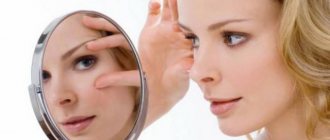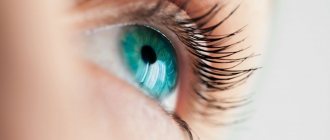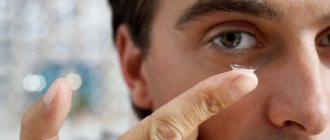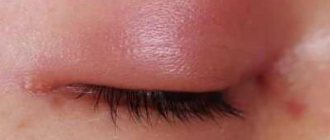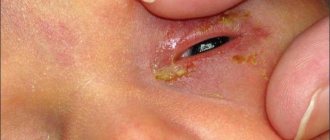Hydrogen peroxide is the most popular and affordable antiseptic for first aid, which can be found in any home medicine cabinet.
Peroxide is successfully used not only in medical practice, but also for household and cosmetic purposes.
If the procedures are carried out carelessly, the solution may get into the eyes, causing irritation of the mucous membrane.
Important! If peroxide has entered the organ of vision, you need to know how to recognize the symptoms of corneal damage and what to do to prevent possible consequences.
Symptoms upon exposure
Accidental contact of hydrogen peroxide with the eyes when wiping the skin of the face or carelessly opening the container with the solution causes an unpleasant burning sensation, however, it does not cause harm to health.
A serious danger is posed by undiluted peroxide at a concentration of 30% , which enters the organ of vision in large quantities.
This often leads to a corneal burn, which can be recognized by the following signs:
- redness of the eyes;
- acute pain syndrome;
- photosensitivity;
- swelling in the eyelid area;
- profuse lacrimation;
- eyelash loss;
- burning sensation;
- the appearance of ulcerative formations on the mucous membrane.
In special cases, peroxide that gets into the eye can lead to a sharp deterioration in vision .
Keep in mind! If exposed to high concentrations of peroxide, the victim may go blind.
How to provide first aid?
Regardless of the concentration and volume of the antiseptic solution that gets into the eye, the victim should be given first aid as quickly as possible to prevent the development of complications.
This is not difficult to do, so even a person without medical education who is next to the patient at a critical moment can cope with the task.
The sequence of actions when providing first aid to adult and small patients is almost identical.
For an adult
What to do? If the solution gets into the eye of an adult, you should proceed to the following actions:
- Rinse the affected organ of vision with cool running water. This will help reduce the concentration of the solution and remove it from the mucous membrane. You can also use liquid from a kettle. It is important to consider the water temperature. If you wish, you can wash your eyes with water collected in a container - you need to lower your face into it, opening your eyes as much as possible.
- In order to partially soothe the mucous membrane and prevent the spread of infection, Levomycetin drops into the eyes Before using them, you should read the instructions and make sure there are no contraindications.
- Take a horizontal position, close your eyes and cover them with a clean, dry napkin . Lie down for 10-15 minutes. During this time, the severity of symptoms should decrease.
If the victim was wearing lenses at the time of the incident, they must be removed before the procedure.
Note! They need to be placed in a special solution and not worn for the next few days.
To kid
If peroxide gets into the eyes of a small child, first of all it is necessary to calm the baby, and then proceed to the procedure :
- Rinse the child's eyes carefully with running water or using a pipette using boiled water at room temperature. Manipulations should be performed smoothly, with minimal pressure on the eyes and without sudden movements.
- After rinsing, remove any remaining water with a dry cloth, place the child on the bed and ask the little patient to close his eyes, covering them with a paper napkin.
- After providing first aid, contact an ophthalmologist for an examination and assessment of the extent of the damage .
Recipes with hydrogen peroxide from Dr. Neumyvakin
To treat various diseases, different recipes using peroxide are used.
To treat this disease, you need to mix 15 drops of H2O2 and a tablespoon of water. The resulting solution should be used as nasal drops.
After instillation, mucus will begin to form in the nasal sinuses, which must be carefully blown out.
Osteochondrosis
Before you start using Neumyvakin treatment recipes, it is recommended to cleanse the body. This way the effectiveness of treatment will be higher.
How to get rid of nail fungus
- Dilute peroxide with water (1:1).
- Keep a finger affected by fungal bacteria in the resulting solution for 30 minutes, then wipe dry.
The course lasts depending on the severity of the disease; it can be continued for several months.
Sore throat is treated by gargling. 1 tsp dissolve peroxide in ¼ glass of water, gargle and gargle. In the area of the tonsils, hold the solution a little.
Sinusitis
Sinusitis can be cured by dripping peroxide solution into the nose.
To do this, you need to dilute 15 drops of peroxide in 1 tbsp. water. Pipette the prepared solution and drop it into both nostrils.
After this, mucus will be released, it should be carefully removed from the nose.
Periodontal disease
To cure periodontal disease you need to prepare a mixture - 3 grams of baking soda, add 10 drops of lemon juice and 20 drops of hydrogen peroxide.
You need to brush your teeth with this mixture and do not put anything in your mouth for 15 minutes. This method will also help if your gums are sore or inflamed.
A solution of hydrogen peroxide can cure a runny nose both for common colds and for viral diseases.
You need to drop two drops of solution (3% peroxide to two parts water) into your nose. Then completely free your nose of mucus and secretions. After the procedure, do not eat or drink for 15 minutes.
Treatment of wounds
Children tolerate hydrogen peroxide well when treating wounds. It does not sting or cause discomfort, it cannot get dirty, and peroxide stops bleeding well.
Papillomas
External use of a 3% peroxide solution will help if papillomas have formed on the skin. In this case, 1 drop of peroxide every 5 hours is sufficient.
Peroxide can help with otitis media. For treatment, you need to dilute 15 drops of peroxide in 30 ml of water. You need to lie down so that the sore ear is on top and drop half of the solution into the ear.
After 10 minutes, slowly tilt your head so that the remaining solution flows out.
Psoriasis can be treated with compresses with hydrogen peroxide. 2-3 tsp. A 3% solution should be diluted in half a glass of boiled water. Apply such compresses to the damaged areas for an hour to an hour and a half, and within 30 days even the densest formations will resolve.
Cracked heels
Often in adulthood, cracks appear on the heels. To get rid of them and tidy up your feet, you can take hot baths with hydrogen peroxide. For this, 4 tbsp. 3% peroxide should be mixed with 1500 ml of warm water and poured into a container that is comfortable for the feet.
If the skin is only slightly rough, 10 minutes of treatment is sufficient. If the heels are roughened, the cracks are deep, then the duration of the bath should be at least 20 minutes.
Prostatitis
To cure prostatitis, you can do warm enemas with peroxide or drink a peroxide solution according to the Neumyvakin scheme (three times a day, increasing the dosage to 30 drops).
Stomach and gastrointestinal tract
Drinking a peroxide solution according to Neumyvakin’s method can also cure the stomach, including gastritis, and improve the functioning of the gastrointestinal tract.
Joints
It is good to apply compresses with a 3% peroxide solution to sore joints and accompany the treatment with internal administration of the solution for two months.
Rheumatoid arthritis is best treated with injections for 10 days. The dosage in this case is prescribed by the attending physician.
Haemorrhoids
Peroxide-based lotions can cure hemorrhoids. The process takes place in a horizontal position and takes no more than 15 minutes. Apply a cotton swab soaked in a 3% peroxide solution to the affected areas.
Eye diseases
Hydrogen peroxide can also cope with eye diseases. To do this, you need to rinse your eyes with a 0.5% peroxide solution. It is dangerous to use a more saturated solution.
Hydrogen peroxide treatment is an affordable alternative treatment for many diseases. It is very important to follow the rules for using peroxide so as not to harm the body.
The best remedy for stomatitis is rinsing with hydrogen peroxide and then using Aftofix on the sores.
What does Aftofix taste like? gag reflex for many medications
just sour, no chemical or medicinal aftertaste, on the contrary, it’s great for nausea)
When should you go to the hospital for help?
You should know! It is necessary to go to a medical facility after getting peroxide in your eyes if:
- a large amount of undiluted hydrogen peroxide entered the organ of vision ;
- there is no opportunity to provide timely first aid to the victim;
- the victim has recently suffered an eye injury or damage to the conjunctiva;
- there could be an infection in the eye;
- The patient showed signs of a purulent infection.
If unpleasant symptomatic manifestations in the form of burning and pain do not disappear after first aid or become more pronounced, you should immediately consult a specialist.
Possible consequences and complications
The most common complications of a burn are infectious. Damaged tissues become convenient entry points for bacteria, and against the background of a burn, purulent inflammatory processes easily develop - conjunctivitis, blepharitis, keratitis, which can lead to the spread of infection further into the eyeball.
A long-term burn, even without inflammatory complications, can lead to the development of a cataract - an opaque area of the cornea that impairs vision or completely prevents the damaged eye from seeing.
How to avoid them
You can avoid complications by promptly seeking medical help. The doctor will prescribe eye drops with antibiotics and agents that accelerate corneal recovery.
This eliminates bacteria, prevents severe bacterial complications from developing and reduces the risk of cataract formation.
Treatment after first aid
After providing first aid and visiting an ophthalmologist, the victim may require additional treatment.
To avoid negative consequences, taking into account the individual characteristics of the patient’s body and the severity of symptoms, the doctor may prescribe:
- Balarpan. Eye drops that stimulate the regenerative processes of the cornea. Contraindications for use are hypersensitivity to the components of the solution, pregnancy and breastfeeding, as well as children under 12 years of age.
- Solcoseryl. A combined preparation for topical use in gel form, used for healing and tissue regeneration. The medication restores normal metabolism and accelerates the healing process of affected areas.
- Albucid. Eye drops with antibacterial and bacteriostatic effects. The drug is safe to use during pregnancy and lactation and is suitable for treating young children. Rarely causes side effects.
- Okomistin. A medicinal solution with antimicrobial, antiviral and antiseptic effects. The drug enhances the body's defense response and can be used as a prophylaxis for purulent-inflammatory complications.
- Tobramycin. A broad-spectrum antibiotic that has a bactericidal and antibacterial effect. The drug has many side effects and is prescribed with caution to patients with renal failure, children and pregnant women.
- Korneregel. An ophthalmic drug in the form of a gel with a pronounced regenerating effect for the treatment of the cornea of the eye. The gel has anti-inflammatory activity and quickly eliminates any symptomatic manifestations of eye diseases.
For your information! Alternative medicine also offers simple and safe remedies, the action of which is aimed at accelerating the healing of the mucous membrane of the eyes and eyelids affected by peroxide due to a chemical burn.
The most effective treatments are the following:
- compress with sea buckthorn oil . Has a beneficial effect on the mucous membrane, is actively used to moisturize the eyes, eliminates burning and itching;
- compress with chamomile infusion . It has anti-inflammatory properties and bacteriostatic activity, which eliminates swelling, redness and burning;
- infusion of dill seeds. Indicated for the treatment and prevention of ophthalmic diseases. The product improves metabolic processes in the retina and prevents a decrease in visual acuity;
- decoction based on oak bark. It has a healing and anti-inflammatory effect, reduces pain and has a positive effect on the speed of the regeneration process of affected areas.
Note! Traditional medicine recipes can be used either independently or in addition to the main course of treatment.
But before using them, you should consult your doctor.
Alcohol got into my eye. Eye burns with alcohol: what to do
An eye burn with alcohol belongs to the category of chemical burns. If this burn occurs, after examining the affected eye by a surgeon, the patient should be referred to an ophthalmologist for observation and prevention of visual impairment.
An eye burn with alcohol is accompanied by severe pain and traumatic shock. In this regard, special care is required when handling the patient. Alcohol of any origin has the ability to absorb moisture inside the eye: dissolve the protein, affect the lens and cornea, and when penetrating into the blood, act as a poison.
Drug treatment of eye burns with alcohol
Due to the occurrence of an eye burn due to the ingress of alcohol and alcohol-containing components into it, treatment is complicated by the increased level of hyperemia and infiltration of the conjunctiva of the eyeball. Patients often complain of photophobia, lacrimation and blepharospasm. Consider the following examples of treating an eye burn with alcohol.
- Prevention of infection: eye ointments with antibiotics, antiseptic drops - up to 4 times a day.
- Neutralization of blood intoxication by necrolysis products. It is carried out using autologous blood with the addition of an antibiotic in the form of an injection under the conjunctiva of the eye.
- Prevention of scarring between the eyeball and the conjunctiva of the eyelids: applying eye ointment and using contact lens inserts.
- Stimulation of the regenerative abilities of the cornea. To do this, use 4% taufon drops, or 0.01% balarpan drops up to 4 times a day. It is also recommended to apply Solcoseryl gel or 20% Octovegin ointment - 2 times a day. In the absence of these medications, you can use sea buckthorn oil.
- Burning the eye with alcohol can cause iridocyclitis. This disease should be prevented with 1% atropine and diclofenac (orally). For increased intraocular pressure, timolol drops are used in a dosage of 0.25 to 0.5%.
Eye burn with alcohol: surgical treatment methods
If surgical intervention is necessary, take into account the threat of perforation of the membranes of the eye, the degree of compression of the vascular network of the fundus due to perilimbal edema. In case of an eye burn with alcohol, the following surgical methods are possible:
- scleroplasty using a conjunctival flap (according to Kunt). Can be carried out within 12 to 24 hours from the moment of injury;
- layered keratoplasty for tectonic and therapeutic purposes;
- keratoplasty to eliminate post-burn cataract. It is carried out 4-6 months after an eye burn;
- Having experienced a chemical burn to the eye, a person can recover faster with the help of general restorative postoperative therapy: the use of antibiotics, vitamins, and various eye ointments.
Eye burns from alcohol-containing substances are dangerous not only from a physiological point of view. Complete or partial loss of vision can lead to great psychological trauma. When treating such a burn, in addition to physiological rehabilitation, the psychological side of the problem should also be taken into account.

